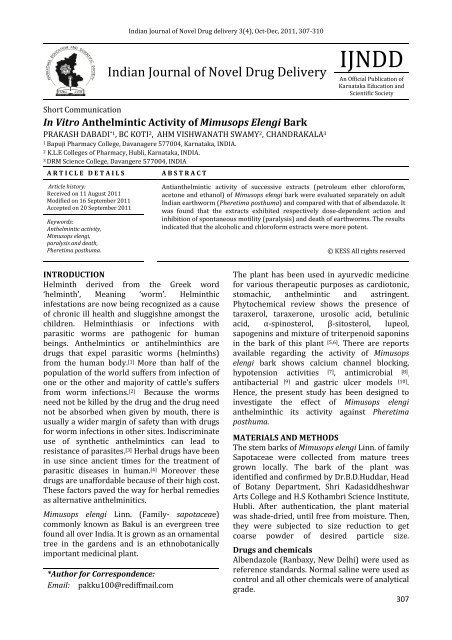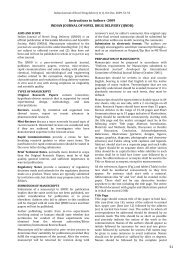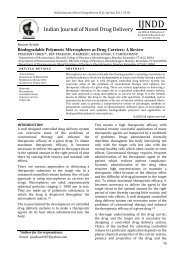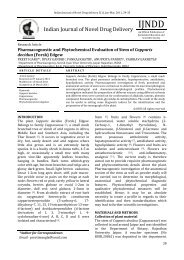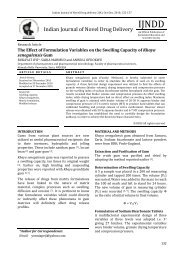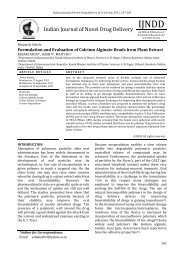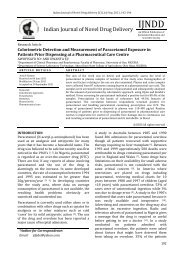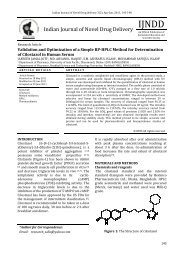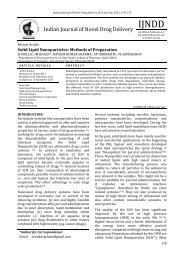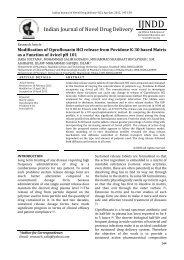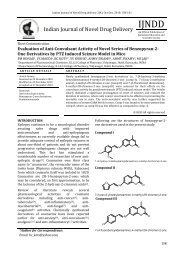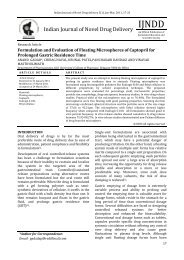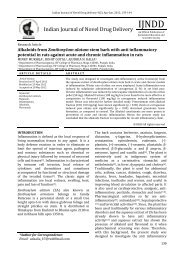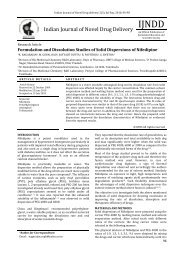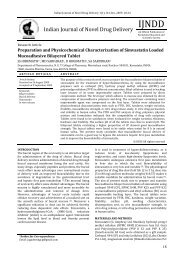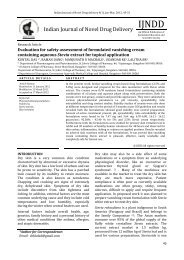In Vitro Anthelmintic Activity of Mimusops Elengi Bark
In Vitro Anthelmintic Activity of Mimusops Elengi Bark
In Vitro Anthelmintic Activity of Mimusops Elengi Bark
Create successful ePaper yourself
Turn your PDF publications into a flip-book with our unique Google optimized e-Paper software.
<strong>In</strong>dian Journal <strong>of</strong> Novel Drug delivery 3(4), Oct-Dec, 2011, 307-310<br />
<strong>In</strong>dian Journal <strong>of</strong> Novel Drug Delivery<br />
IJNDD<br />
An Official Publication <strong>of</strong><br />
Karnataka Education and<br />
Scientific Society<br />
Short Communication<br />
<strong>In</strong> <strong>Vitro</strong> <strong>Anthelmintic</strong> <strong>Activity</strong> <strong>of</strong> <strong>Mimusops</strong> <strong>Elengi</strong> <strong>Bark</strong><br />
PRAKASH DABADI *1 , BC KOTI 2 , AHM VISHWANATH SWAMY 2 , CHANDRAKALA 3<br />
1 Bapuji Pharmacy College, Davanagere 577004, Karnataka, INDIA.<br />
2 K.L.E Colleges <strong>of</strong> Pharmacy, Hubli, Karnataka, INDIA.<br />
3 DRM Science College, Davangere 577004, INDIA<br />
A R T I C L E D E T A I L S<br />
Article history:<br />
Received on 11 August 2011<br />
Modified on 16 September 2011<br />
Accepted on 20 September 2011<br />
Keywords:<br />
<strong>Anthelmintic</strong> activity,<br />
<strong>Mimusops</strong> elengi,<br />
paralysis and death,<br />
Pheretima posthuma.<br />
A B S T R A C T<br />
Antianthelmintic activity <strong>of</strong> successive extracts (petroleum ether chlor<strong>of</strong>orm,<br />
acetone and ethanol) <strong>of</strong> <strong>Mimusops</strong> elengi bark were evaluated separately on adult<br />
<strong>In</strong>dian earthworm (Pheretima posthuma) and compared with that <strong>of</strong> albendazole. It<br />
was found that the extracts exhibited respectively dose-dependent action and<br />
inhibition <strong>of</strong> spontaneous motility (paralysis) and death <strong>of</strong> earthworms. The results<br />
indicated that the alcoholic and chlor<strong>of</strong>orm extracts were more potent.<br />
© KESS All rights reserved<br />
INTRODUCTION<br />
Helminth derived from the Greek word<br />
‘helminth’, Meaning ‘worm’. Helminthic<br />
infestations are now being recognized as a cause<br />
<strong>of</strong> chronic ill health and sluggishne amongst the<br />
children. Helminthiasis or infections with<br />
parasitic worms are pathogenic for human<br />
beings. <strong>Anthelmintic</strong>s or antihelminthics are<br />
drugs that expel parasitic worms (helminths)<br />
from the human body. [1] More than half <strong>of</strong> the<br />
population <strong>of</strong> the world suffers from infection <strong>of</strong><br />
one or the other and majority <strong>of</strong> cattle’s suffers<br />
from worm infections. [2] Because the worms<br />
need not be killed by the drug and the drug need<br />
not be absorbed when given by mouth, there is<br />
usually a wider margin <strong>of</strong> safety than with drugs<br />
for worm infections in other sites. <strong>In</strong>discriminate<br />
use <strong>of</strong> synthetic anthelmintics can lead to<br />
resistance <strong>of</strong> parasites. [3] Herbal drugs have been<br />
in use since ancient times for the treatment <strong>of</strong><br />
parasitic diseases in human. [4] Moreover these<br />
drugs are unaffordable because <strong>of</strong> their high cost.<br />
These factors paved the way for herbal remedies<br />
as alternative anthelminitics.<br />
<strong>Mimusops</strong> elengi Linn. (Family- sapotaceae)<br />
commonly known as Bakul is an evergreen tree<br />
found all over <strong>In</strong>dia. It is grown as an ornamental<br />
tree in the gardens and is an ethnobotanically<br />
important medicinal plant.<br />
*Author for Correspondence:<br />
Email: pakku100@rediffmail.com<br />
The plant has been used in ayurvedic medicine<br />
for various therapeutic purposes as cardiotonic,<br />
stomachic, anthelmintic and astringent.<br />
Phytochemical review shows the presence <strong>of</strong><br />
taraxerol, taraxerone, urosolic acid, betulinic<br />
acid, α-spinosterol, β-sitosterol, lupeol,<br />
sapogenins and mixture <strong>of</strong> triterpenoid saponins<br />
in the bark <strong>of</strong> this plant [5,6] . There are reports<br />
available regarding the activity <strong>of</strong> <strong>Mimusops</strong><br />
elengi bark shows calcium channel blocking,<br />
hypotension activities [7] , antimicrobial [8] ,<br />
antibacterial [9] and gastric ulcer models [10] .<br />
Hence, the present study has been designed to<br />
investigate the effect <strong>of</strong> <strong>Mimusops</strong> elengi<br />
anthelminthic its activity against Pheretima<br />
posthuma.<br />
MATERIALS AND METHODS<br />
The stem barks <strong>of</strong> <strong>Mimusops</strong> elengi Linn. <strong>of</strong> family<br />
Sapotaceae were collected from mature trees<br />
grown locally. The bark <strong>of</strong> the plant was<br />
identified and confirmed by Dr.B.D.Huddar, Head<br />
<strong>of</strong> Botany Department, Shri Kadasiddheshwar<br />
Arts College and H.S Kothambri Science <strong>In</strong>stitute,<br />
Hubli. After authentication, the plant material<br />
was shade-dried, until free from moisture. Then,<br />
they were subjected to size reduction to get<br />
coarse powder <strong>of</strong> desired particle size.<br />
Drugs and chemicals<br />
Albendazole (Ranbaxy, New Delhi) were used as<br />
reference standards. Normal saline were used as<br />
control and all other chemicals were <strong>of</strong> analytical<br />
grade.<br />
307
Prakash Dabadi et al / <strong>In</strong>dian Journal <strong>of</strong> Novel Drug Delivery 3(4), Oct-Dec, 2011, 307-310<br />
Table 1: <strong>Anthelmintic</strong> <strong>Activity</strong> <strong>of</strong> <strong>Mimusops</strong> elengi <strong>Bark</strong> Extracts<br />
Group Treatment Concentration<br />
(mg/ml)<br />
Paralysis time<br />
(min.)<br />
1 Vehicle - - -<br />
2 Albendazole 25<br />
3 Petroleum ether 25<br />
4 Chlor<strong>of</strong>orm 25<br />
5 Alcoholic extract 25<br />
6 Acetone 25<br />
All values represent Mean +SD; n= 6 in each group<br />
50<br />
100<br />
50<br />
100<br />
50<br />
100<br />
50<br />
100<br />
50<br />
100<br />
10.01±0.10<br />
7.03±0.32<br />
6.08±0.21<br />
45.08±0.15<br />
38.12±0.16<br />
22.13±0.24<br />
20.13±0.24<br />
16.14±0.20<br />
11.38±0.32<br />
13.03±0.16<br />
10.66±0.18<br />
7.82±0.25<br />
104.24±0.18<br />
97.05±0.85<br />
66.01±0.24<br />
Death Time<br />
(min.)<br />
15.04±0.14<br />
11.04±0.23<br />
10.04±0.12<br />
66..25±0.22<br />
45.10±0.28<br />
36.06±0.12<br />
27.19±0.14<br />
19.11±0.12<br />
15.53±0.24<br />
18.70±0.24<br />
14.17±0.12<br />
11.74±0.26<br />
124.15±0.26<br />
78.04±0.12<br />
56.04±0.27<br />
Preparation <strong>of</strong> the Extract<br />
The powdered material was subjected to<br />
successive extraction in a Soxhlet apparatus<br />
using solvent petroleum ether (40-60°C),<br />
chlor<strong>of</strong>orm, acetone and alcohol. The<br />
concentrated extract was then taken in a China<br />
dish and evaporated on a thermostat controlled<br />
water bath till it forms a thick paste. This thick<br />
mass was kept for vacuum drying in desiccators<br />
till it become free from moisture. The soluations<br />
were prepared 10, 50, 100mg/ml.<br />
Animals<br />
<strong>In</strong>dian adult earthworms (Pheretima posthuma)<br />
collected from moist soil and washed with<br />
normal saline to remove all faecal matter were<br />
used for the anthelmintic study. The earthworms<br />
<strong>of</strong> 3-5 cm in length and 0.1-0.2 cm in width were<br />
used for all the experimental protocol due to<br />
their anatomical and physiological resemblance<br />
with the intestinal roundworm parasites <strong>of</strong><br />
human beings.<br />
<strong>Anthelmintic</strong> activity<br />
The anthelmintic activity was performed<br />
according to the method (Ghosh et al) [11] . On<br />
adult <strong>In</strong>dian earth worm Pheretima pothuma as it<br />
has anatomical and physiological resemblance<br />
with the intestinal round worm parasites <strong>of</strong><br />
human beings. Pheretima pothuma was placed in<br />
petridish containing three different<br />
concentrations (25, 50,100mg/ml) each <strong>of</strong><br />
<strong>Mimusops</strong> elengi (petroleum ether, chlor<strong>of</strong>orm,<br />
acetone and alcoholic extract) solutions. Each<br />
petridish was placed with 6 worms and observed<br />
for paralysis (or) death. The mean time for<br />
paralysis was noted when no movement <strong>of</strong> any<br />
sort could be observed, except when the worm<br />
was shaken vigorously, the time death <strong>of</strong> worm<br />
(min) was recorded after ascertaining that<br />
worms neither moved when shaken or when<br />
given external stimuli. <strong>In</strong> the same manner<br />
albendazole was included as reference<br />
compound. The Test results were compared with<br />
Reference compound albendazole (25, 50, 100<br />
mg/ml) treated samples.<br />
RESULTS AND DISCUSSION<br />
The results <strong>of</strong> anthelmintic activity are shown in<br />
Table 1. Preliminary phytochemical studies on<br />
<strong>Mimusops</strong> elengi bark revealed the presence <strong>of</strong><br />
like alkaloids, tannin, saponins, taraxerone,<br />
taraxerol, ursolic acid, betulinic acid, α-<br />
spinosterol, β-sitosterol [5] , querrcitol [6] , lupeol<br />
[7], isoretronecyl tigalate [8] and mixture <strong>of</strong><br />
triterpenoid saponins [9,10] , steroidal saponin, β-<br />
sitosterol. Some <strong>of</strong> these phytoconstituents may<br />
be responsible to show a potent anthelmintic<br />
activity. From the result both alcoholic and<br />
chlor<strong>of</strong>orm extract <strong>of</strong> <strong>Mimusops</strong> elengi bark<br />
showed an anthelmintic activity when compared<br />
to the standard drug. Each crude extract at the<br />
308
Prakash Dabadi et al / <strong>In</strong>dian Journal <strong>of</strong> Novel Drug Delivery 3(4), Oct-Dec, 2011, 307-310<br />
concentration <strong>of</strong> 25, 50 and 100 mg/ml produced<br />
anthelmintic activity in dose dependent manner<br />
giving shortest time <strong>of</strong> paralysis (P) and death<br />
(D) with 100 mg/ml concentration. Alocholic<br />
extract <strong>of</strong> <strong>Mimusops</strong> elengi bark at concentration<br />
<strong>of</strong> 100 mg/ ml caused paralysis in 7.8min and<br />
death in 11.74 min, while chlor<strong>of</strong>orm extract<br />
showed paralysis in 11.38 min and death in<br />
15.53 min against Pheritima postuma. The<br />
reference drug albendazole showed the same at<br />
6.08 min and 10.04 min respectively. The<br />
predominant effect <strong>of</strong> albendazole on the worm<br />
is to cause a flaccid paralysis that result in<br />
expulsion <strong>of</strong> the worm by peristalsis.<br />
Albendazole by increasing chloride ion<br />
conductance <strong>of</strong> worm muscle membrane<br />
produces hyper polarisation and reduced<br />
excitability that leads to muscle relaxation and<br />
flaccid paralysis. [12] The crude extracts <strong>of</strong><br />
<strong>Mimusops</strong> elengi revealed the presence <strong>of</strong> tannins<br />
as one <strong>of</strong> the chemical constituents. Tannins<br />
were shown to produce anthelmintic<br />
activities. [13] Chemically tannins are polyphenolic<br />
compounds. [14] Some synthetic phenolic<br />
anthelmintics (eg) niclosamide, oxyclozanide and<br />
bithionol are shown to interfere with energy<br />
generation in helminth parasites by uncoupling<br />
oxidative phosphorylation. [15] It is possible that<br />
tannins contained in the extracts <strong>of</strong> <strong>Mimusops</strong><br />
elengi produced similar effects. Another possible<br />
anthelmintic effect <strong>of</strong> tannins is that they can<br />
bind to free proteins in the gastro intestinal tract<br />
<strong>of</strong> host animal [16] or glycoprotein on the cuticle<br />
<strong>of</strong> the parasite [17] and causes death. <strong>In</strong><br />
conclusion, the traditional claim <strong>of</strong> <strong>Mimusops</strong><br />
elengi as an anthelmintic activity has been<br />
confirmed as the extracts showed potent activity<br />
against Pheritima postuma. Further studies are<br />
necessary to isolate and reveal the active<br />
compound contained in the crude extracts <strong>of</strong><br />
<strong>Mimusops</strong> elengi responsible for activity and to<br />
establish the mechanism <strong>of</strong> action are required.<br />
CONCLUSION<br />
<strong>In</strong> conclusion, the present study has shown that,<br />
all the extract <strong>of</strong> <strong>Mimusops</strong> elengi bark have<br />
significant anthelmintic activity, the alcoholic<br />
and chlor<strong>of</strong>orm extract being more potent.<br />
Further, it would be interesting to isolate and<br />
possible active phytoconstituents responsible for<br />
the anthelmintic activity and study its<br />
pharmacological actions.<br />
REFERENCES<br />
[1] The Merck <strong>In</strong>dex, 12th Ed., page 1119:<br />
entry 6611 Nicotine, Merck & Co. 1996.<br />
[2] Blakemore R. Diversity <strong>of</strong> exotic<br />
earthworms in Australia- A status report.<br />
Transactions <strong>of</strong> the Royal Zoological<br />
Society <strong>of</strong> New SouthWales, 1999.<br />
[3] Singh D, Swarnkar CP, Khan FA.<br />
Anthelminthic resistance in<br />
gastrointestinal nematodes in livestock in<br />
<strong>In</strong>dia. J Vet Parasit 2002; 16:115-130.<br />
[4] Chopra RN, Nayer SC, Chopra IC. Glossary<br />
<strong>of</strong> <strong>In</strong>dian medicinal plants. CSIR, New Delhi<br />
1956; 160.<br />
[5] Misra, G., and Mitra, C.R., Constituents <strong>of</strong><br />
leaves, hard wood and roots <strong>of</strong> <strong>Mimusops</strong><br />
elengi phy-tochemistry, Bangl. J. Vet. Med.,<br />
7(3): 501-502, 1968.<br />
[6] Varsheny, I.P., and Badhawar, G., Saponins<br />
and sapogenins <strong>of</strong> <strong>Mimusops</strong> elengi, Proc.<br />
Nat. Aca. Sci., 41: 21-23, 1972.<br />
[7] Dar A, Behbahanian S, Malik A, Jahhan N.<br />
Hypotensive effect <strong>of</strong> the Methanolic<br />
extract <strong>of</strong> <strong>Mimusops</strong> elengi in normotensive<br />
rats. Phytomedicine Nov1999;6: 373-378.<br />
[8] Mundhada SS, and Tatke PA. Preliminary<br />
photochemical investigation and<br />
Antimicrobial activity <strong>of</strong> fruits <strong>of</strong> <strong>Mimusops</strong><br />
elengi Linn. <strong>In</strong>dian drugs 2005 July, 42 (7),<br />
417-423.<br />
[9] Murudkar A, Mundhada SS, Tatke PA.<br />
Antibacterial activity <strong>of</strong> <strong>Mimusops</strong> elengi<br />
bark against Dental pathogens. <strong>In</strong>dian J<br />
Pharm Educ Res 2007; 41(2):114-120.<br />
[10] Payal J, Shah, Mitesh S, Gandhi, Mamta B.<br />
Shah, Sunita S, Goswami, Devadas Santani.<br />
Study <strong>of</strong> <strong>Mimusops</strong> elengi bark in<br />
experimental gastric ulcers. J Ethnopharm<br />
col 2003; 89: 305-311.<br />
[11] Ghosh T, T.K.Maity, A.Bose and G.K.Dash.<br />
(2005). <strong>Anthelmintic</strong> activity <strong>of</strong> Bacopa<br />
monierri,<strong>In</strong>dian. J.nat Product ,21; 16-19.<br />
[12] Martin RJ. γ-amino butyric acid and<br />
piperazine activated single channel current<br />
from Ascaris suum body muscle. Br J<br />
Pharmacol 1985; 84:445-461.<br />
[13] Niezen JH, Waghorn GC, Charleston WAG.<br />
Growth and gastro intestinal nematode<br />
parasitism in lamps grazing either Lucerne<br />
(Medicago sativa) or sulla (hedysarum<br />
coronarium), which contains condensed<br />
tannins. J Agri Sci 1995; 125:281-289.<br />
[14] Bate smith EC. The Phenolic constituent <strong>of</strong><br />
plants and their taxonomic significance,<br />
dicotyledons. J Linn Soc Bot 1962; 58:95-<br />
103.<br />
309
Prakash Dabadi et al / <strong>In</strong>dian Journal <strong>of</strong> Novel Drug Delivery 3(4), Oct-Dec, 2011, 307-310<br />
[15] Martin RJ. Mode <strong>of</strong> action <strong>of</strong> anthelmintic<br />
drugs. Vet J 1997; 154:11-34.<br />
[16] Athnasiadou S, Kyriazakis I, Jackson F,<br />
Coop RL. Direct anthelmintic effects <strong>of</strong><br />
condensed tannins towards different<br />
gastro intestinal nematodes <strong>of</strong> sheep: <strong>In</strong><br />
vitro and in vivo studies. Vet Parasitol<br />
2001; 99:205-219.<br />
[17] Thompson DP, Geary TG. The structure and<br />
function <strong>of</strong> helminth surfaces. <strong>In</strong>: Marr JJ<br />
Editor. Biochemistry and Molecular Biology<br />
<strong>of</strong> Parasites. 1 st ed. Academic Press, New<br />
York, 1995, pp. 203-32.<br />
310


